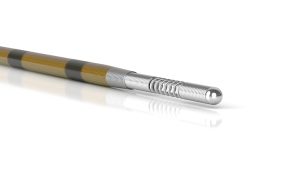Epimed

La fibrosi epidurale
Una causa comune del dolore cronico è costituita dall'esistenza di cicatrici nello spazio epidurale. Lo spazio epidurale è un'area sottile tra l'interno della colonna vertebrale e lo strato protettivo intorno al midollo spinale. La creazione di questo tessuto cicatriziale può limitare il percorso naturale dei nervi causando infiammazioni e quindi la conseguente generazione di dolore.
Epimed: Cateteri e introduttori epidurali
Epimed ha sviluppato una linea avanzata di cateteri epidurali radiopachi guidabili tramite fluoroscopia (raggi X). L'operatore andrà ad inserire la guida nello spazio epidurale nel punto ottimale in relazione alla regione interessata (generalmente il percorso prevede il passaggio caudale attraverso il lato sacrale, una cavità naturale della colonna situata all'estremità del coccige). Il movimento del catetere può quindi essere controllato attraverso il monitor e guidato con precisione alla radice del nervo interessato. I cateteri Epimed hanno una punta morbida non dannosa, ottimizzata per scivolare sulle zone sensibili e un corpo robusto facilmente manovrabile all'interno dello spazio epidurale. Una volta che il catetere si trova in posizione, è possibile iniettare il farmaco che raggiungerà quindi direttamente la sorgente che genera il dolore.

Cateteri di Racz®

I cateteri epidurali di Racz® sono fabbricati in acciaio inossidabile con la caratteristica configurazione a molla. L'estremità distale è flessibile, non rivestita e arrotondata. La configurazione delle spire conferisce una massima flessibilità in fase di guida e la possibilità di infusione laterale.
Tutti i cateteri Epimed presentano una notevole resistenza alle trazioni ed eventuali rotture limitando l'allungamento del catetere su base longitudinale, mentre le bobine a molla lo rendono resistente alle sollecitazioni meccaniche.
| Catetere di Racz® BREVI-XL/2 19G (35,60 cm) |
Catetere di Racz® BREVI-STF™ 19G (35,60 cm) |
| Morbido e manovrabile per fornire maggiore controllo e stabilità. Risulta particolarmente performante nell'infusione transforaminale ed epidurale in situazioni anatomiche complesse, causate da aderenze e spazi cicatriziali estesi. | Catetere derivante dal BREVI-XL/2® con mandrino leggermente più spesso per aumentare la rigidità. Il corpo del catetere mantiene una punta arrotondata ed atraumatica. Dedicato ai posizionamenti molto difficoltosi. |
| Catetere di Racz® TUN-L-XL™/24 19G (61 cm) |
Catetere di Racz® VERSA-KATH® 21G (30,5 cm e 61 cm) |
| Di lunghezza maggiore per raggiungere i punti più lontani. La punta presenta una dilatazione maggiore delle spire per far diffondere il farmaco più facilmente. Indicato per pazienti con aderenze su diversi piani. | Dal corpo molto robusto con punta morbida. Il calibro ridotto e la piccola lunghezza aiutano il posizionamento per le procedure cervicali o transforaminali. |
Aghi Introduttori

| RX-2 Ago introduttore RX-2™ Coudé® (14G - 10,15 cm; 16G - 8,90 cm; 18G - 8,90 cm) |
| Gli aghi introduttori RX-2™ Coudé® sono brevettati e progettati per un inserimento atraumatico, preciso e facilitato del catetere nello spazio epidurale. Realizzati in acciaio inossidabile 304V, non contengo lattice e PVC. |
Aghi per blocchi nervosi
Gli aghi BELLA D® e BLUNT per il blocco dei nervi sono idonei per la somministrazione di agenti anestetici per procedure di anestesia locale.
L’introduttore a cannula flessibile è idoneo per l’inserimento nello spazio epidurale di agenti anestetici per procedure di anestesia regionale, direttamente o tramite un catetere.
| Ago BLUNT | Ago BELLA D® COUDÉ |
 Gli aghi Blunt sono aghi con punta a matita non tagliente con foro laterale che consente al farmaco di essere distribuito attorno alla punta dell’ago e direttamente sul bersaglio nervoso. La punta smussa consente di ridurre al minimo il rischio di danni ai tessuti, ai nervi o coinvolgimento articolare. Questo design può ridurre le complicanze del trattamento del dolore acuto e cronico come iniezioni intra-arteriose e / o intra-neuronali.
|
 È un ago quincke a punta occlusa con un'unica porta laterale per iniezioni direzionali. BELLA D® COUDÉ è progettato per aiutare a evitare iniezioni intra-arteriose e intraneurali, fornendo al contempo il rilascio del farmaco nel sito target.
|






